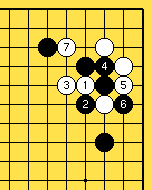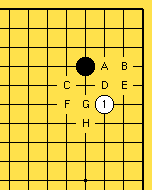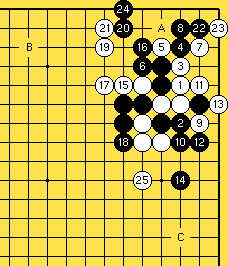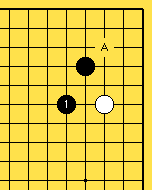
Thank you, thank you and thank you! Welcome to a brand new episode of Gentle Joseki!
Why do I feel like a game-show host here? Well, in a way it's all the same, I guess. Go is a form of art and a game of the mind. And although it sometimes doesn't seem that way, go and game shows alike, in the end it's all about entertainment and having a good time.
Maybe it is because the number of people bother to work their way through Gentle Joseki is increasing. More likely it is just because I repeatedly keep begging people to send me mail but the amount of reactions has steadily been increasing since I started to do this, 3 months ago. Thank you! Mostly the mail I get goes like this:
"Nice job, Pieter! By the way, when white plays on top of a black diagonal clamp play is it better to do A or B, and can you further tell me why white doesn't play C?"
I'm not lying when I say that I'd love to get on a plane, pay you a visit and tell you all I know about this fascinating game (while doing some sightseeing at the side, of course) but it's not going to happen. Answering all your questions in a way they deserve is in other words impossible. The only thing I can try to do to satisfy the reader, you, is what I am doing here, dressing up in a sandwich board, point in the right direction and provide a bad copy of a flimsy map.
To give an example of one such a pointer, the same one I keep repeating from the start of Gentle Joseki 1 by the way, is:
"There is one major drawback to the hoshi play: on its own it barely makes any territory at all!"
What I am trying to get through here is that if you want territory in the corner fine, a perfectly common and correct way of thinking but
*** Do not treat a stone on hoshi as if it where on the 3-3 point! ***
The only way to make real territory is to place your stones on the third line, preferably on the 3-3 point in the corner. Even if you play on komoku (4-3) it is unlikely you'll get a lot of profit here as long as you do not play a follow up enclosing move at the 5-3 point. Without using a bunch of diagrams to show you I'd like you to try the taste of this concept:
By placing a stone on the 4th row you announce that you'd love your opponent to play under your stones because then you can keep him low and prevent your opponent's territory from expanding in an uncontrollable fashion. If your opponent doesn't feel like playing under your stones, or if he doesn't feel like playing anywhere near to your stones, well then you might consider adding a stone or two and start claiming some real territory.
I could easily write a book about the contents of this paragraph alone but in such a book I'll basically repeat this idea over again, using game examples, diagrams and lots of flowery speech. Books are great, of course, but if you can get somewhere yourself, without their help, you'll be able to find your way there for the rest of your life. I hope you can use Gentle Joseki in this way, a means to stimulate the gray mass into getting some sense of direction.
I left a couple of loose ends in Gentle Joseki II and I promise to at least partially go over these this time. Before starting to throw diagrams at you (my favorite past time), however, I'd like to tell you about my Insei (=intern) days. There are lots of insei in Japan, people connected to universities. To be an insei at the Nihon Ki-In (Japanese Go Association), however is something quite different altogether.
The people of the Ki-in in Nagoya were surprised when they saw me at their doorstep back in '88, asking if they would allow me to try to become a go pro. Next, however, it was their turn to surprise me by quietly accepting me as a go student and allowing me to compete in the Insei league. Winning this league is the only way of becoming a pro (Well, there is a national qualifying tournament too, but winning this is next to impossible.). This way one contestant per district (Tokyo-Nagoya-Osaka) gets selected every season to join the ranks of "those-who-have-some-clue-as-what-the-game-is-all-about", the "kishi" or go professionals.
Not knowing too much about Japan when I arrived here and knowing even less about Insei life I had imagined a Spartan like training facility where guys in kimono and wooden clubs mercilessly were beating bad habits out of promising young go players. A daily strict training schedule and hundreds of joseki to be mastered in a fortnight. Severe penalties for those who made the same mistake twice and fierce competition to be dealt with in any which way...?
That was what I expected, and that was what I kind of was looking forward to. Well, as usual when imagining things without enough information, the real thing was nothing like that, not even close. Living in with a professional, like students at a go-dojo (old-style training school) might be a bit closer to my runaway imagination. As it turned out, the only special "Insei" thing is the league every Saturday and Sunday, played during the whole season to determine the next professional. Otherwise the insei are just a bunch of school going kids, brads if you like, who are left on their own. This was my greatest shock after coming to Japan, the realization that
*** There is no recipe for making professionals ***
What I was talking about earlier on, getting some sense of direction, well as an insei you better be able to find your way yourself, and improve fast otherwise you can forget about joining the pro ranks. One thing all the insei had in common though is that they wanted to win badly and that they spend the better half of every day doing something with go. If you want to know the secret about what makes pros here it is:
*** Be eager to win every game and do "something" with go every day ***
Now, you never would have thought of that before, would you?
__EOF;
////////////////////////////////////////////////////////////////////////
//
// PATTERNS
//
$cnt_patterns = array(
array( 'type' => 'p'
, 'text' => <<<__EOF

I can't help myself but I just have to show you some
diagrams. The deal with a play on the 3-3 point is very
simple. You can expect about as much territory as there
are triangles, about 4 points (dia 1)
Diagram 1

In dia 2 you can see that by adding another move black
gets about 8 points worth of territory. It is not so
much but it is pretty solid.
Diagram 2

Dia 3, here black has a played on the 4-3 point
(komoku). Although his territory looks bigger as
compared to dia 1 I think that in terms of solid
territory there is not such a big difference, a play at
komoku is worth about 4 points, maybe 5.
Diagram 3
So, are komoku and san-san (3-3) almost equal in value and efficiency? Certainly not, there is a very good reason why komoku was for ages thought of as the best opening move.

If black finds time to spend another move in the corner
he'll be able to make as much as 11 points worth of
solid territory with the shimari (enclosure) formation
in dia 4. This may not sound as such a big deal but 11
points for two moves comes to over 5 points a move, this
is as much as you can expect.
Diagram 4

In the previous episode of Gentle Joseki there was,
among other things, the following comment by dia 5:
"To make a simple situation even more complex, these
days black never seems to answer white 2 at 3 right away
anymore. Professionals feel that playing the exchange
black 3-white 4 sometimes may favor white. Instead of
black 3, later on in the game black might want to play a
pincer somewhere around white 4 judging from the whole
board position."
Diagram 5
In order to avoid confusion let's first say that the white slide at 2 most of the time is not a bad move, for more about to white 2 click back to Gentle Joseki II. Which raises the next, excellent, points. Why on earth would black be reluctant to play at 3? Or, what alternatives does black have? Well, there are some moves black might want to consider, but, once again, let's first say that black 3 in the dia is rarely a bad move. It might be a slack play at times to answer white 2 and not take the opportunity to do something somewhere else, but that still does not make it into no-good move on its own.
Instead of defending the corner black can think of
creating thickness and letting go of the corner
territory as in dia 6. The sequence shown here is a
peaceful one, however, and black should be prepared to
fight back when white plays 4 at A after which all kind
of hairy sequences could follow. It should be noted that
instead of taking control of the corner with white 2
jumping to B is not good. Black will immediately block
of the corner by playing at 2 himself after which it
becomes clear that the white stones can not easily make
eyes anywhere and they'll have to continue jumping
towards the center in order to prevent black from
attacking.
Diagram 6

White 1 in dia 6a can lead to very difficult situations.
Whatever black does he should not play at 6, after this
move he'll find himself tricked by the delicious squeeze
play of white 7. Black 2, by the way, can also be played
at 4 right away.
Diagram 6a
The fashionable clamp at 1 is another alternative for
black. This move smacks of a trick play but it is
actually a skillful probing move. The sequence shown in
dia 7 is uncomplicated and gives an equal result. This
joseki is a kind of new and it is not yet clear if white
2 is the best response
Diagram 7
The dias 6 and 7 showed 2 alternative ways of playing instead of guarding the corner as in dia 5. This brings me back to the comment of last time: (dia 5)
"Instead of black 3, later on in the game black might want to play a pincer somewhere around white 4 judging from the whole board position."
This is all very nice but what prevents the white player from thwarting black's intention of waiting to see what the best play will be and occupying the 3-3 point with his next move himself? Well nothing, actually.
In dia 8 black did not answer white 1 but played
elsewhere instead. White plays 3 and effectively takes
over the corner territory.
When seeing this result for the first time one is
tempted to think that this is a clear disaster for black
and that nothing can justify taking such a loss in the
corner.
A lot, of course, depends on precisely how big a move
played when ignoring white 1. To judge dia 8 correctly
it is further necessary to know what is at the left side
of the board.
Diagram 8

In dia 9 a situation is shown where it was almost
certainly not a good idea to ignore white's marked move.
After white takes the key-point in the corner with 1 the
black stones have no room to make a two-space extension
towards the left and black cannot expect to make two
eyes locally. Black's stone are afloat and his stones
will most likely keep bothering him until the finally
can get two eyes somewhere.
Diagram 9
Looking at dia 8 and 9 you easily can get the feeling that black never should ignore white's slide! (conveniently forgetting about the value of black's tenuki). For professionals there is, however, still another reason why dia 8 is not such a terrible result for black.

Suppose white has played first in the corner at the 3-3
point. Next black has played an approach move at 1 after
which white extends to 2. Well, so far so good, but...
Diagram 10
Next the questionable exchange of black 3 for white 4 gets played which gives us the same position as in dia 8. Professionals and amateurs alike will, of course, never answer black 3 at 4. White 4 should be at A. All the same, there doesn't seem to be such a big difference between the white play at 4 or A. When comparing these moves the average amateur most probably'll shrug and think "So what, maybe you lost 1 point, no big deal, what's so bad about it for white?"
For pros, however, this is quite different. To be able to make your opponent answer in a submissive way, a way, which does not make efficient use of, previously played stones without compensation, is a very big deal, it's a disaster.
Recently I don't go to observe the professionals play anymore but a couple of years ago when watching the professionals play it often would happen that suddenly in the middle of a game a pro starts beating himself over the head with his fan while screaming out in agony. When you see this happen for the first time you naturally assume that that person must have put his own stones in atari or made a likewise terrible blunder. After the game, however, when following the analyses it is nine times out of ten that the reason for the self-punishment was precisely what I was talking about now, answering submissively and not putting your own stones to optimal use. When a pro realizes that he has played such a move unnecessarily, no matter where or what time of day it is he will feel like walking to a nearby wall and start banging his head against it.
For the white player the 3-4 exchange is terrible. For black it helps justifying letting go of the corner. And, black played on the 4-4 point (hoshi) in the first place, not directly thinking about making territory there, remember? After reading this you now might feel like never taking the corner when playing white as in dia 8. Well, sometimes it might be too early but taking the 3-3 point is a very big move. Also, even though black played on hoshi, black played in the corner first, meaning that IF he lets go of it he should get sufficient compensation. So, if you feel that black's move elsewhere is way too small or doesn't require a direct answer then there's nothing against taking over the corner and being happy.
Now what I'd like you to do is to find somebody who's about your own level and show him the opening of this game. Next you ask what your friend thinks about it and you write down the comments and questions he or she might have. Than you ask your friend to read through Gentle Joseki I-III and repeat the same procedure, I promise you to eat my shorts if your friend comes up with exactly the same comments and questions as when going over the game the first time.
 |
19th Female Honinbo title match, game 5 White: Chinen Kaori, 3 dan Black: Inori Yoko, 5 dan Date: November 22 2000 Moves: 1-27 |
 |
| Chinen Kaori | Inori Yoko |

There is enough to tell about this particular fuseki but I think that the left side especially deserves your attention. It is very interesting to notice that black is reluctant to play at A. The reason for this is that black in a way helps to solidify white's 4-6-8 formation if she'll make the black A, white B exchange. Black is keen on keeping the option of invading at B alive as a means of reducing the white territory.
By forcing her opponent to resign after move 179 Yoko
managed to take the Honinbo title at her first ever
title challenge.
Diagram 11
After black 13 in the upper left corner white choose to play tenuki once. White 14 is an excellent move but does not really force black to answer immediately. Black, however, let go of the chance of playing a second move in the corner at 16. I think taking the 3-3 point with black was a possible move too but after black 15 at 16 white will extend to C which almost certainly requires black to slide in the corner at A. If the game were to be played like that it is suddenly white who is determining the pace in spite of the disadvantage of not having the first move. This is not to black's liking.
The last thing worth noticing is that black choose to block white 20 at 21, and not at 22. The game move at 21 is the correct direction, black emphasizes the whole right side of the board while maintaining "sente" (the initiative). White will have a tough time keeping black's right side under control, invading here is not what white is looking forward to but if she doesn't do something black's right side is sure to become too much solid territory. If black were to play at 22 instead of 21 then the black moyo would never be as impressive. White has a nice moyo-flattening-move at D. White will not have a hard time keeping black's territory from mushrooming. If black would've had a stone at D to start with, however, she might very well have chosen to play 21 at 22.

I do not think I have enough energy left to cover all
these possible responses (my family and I'll be homeless
if we don't find a place to live by December 10) so let
me start with the rarest and most intriguing answer,
black H.
Reference diagram
You will never find a beginners book of go telling you about black H, nor will you be able to find a decent go teacher showing you this move and encouraging to try it. It's a kind of a rogue move which, of course makes it all the more attractive. Don't tell anybody you got it from me. (and don't blame me if you played it and it didn't work out at all)
Black 1 seems to be telling white that he is sealed of and that white better hurry to make two eyes at the right side. However, any go player worth his salt has only one thing in mind playing white:
"how am I going to keep these thin black stones separated".
Diagram 12

White 1 is a natural move, preventing the black stones
to link up and become a thick position. Instead of white
1 there are other moves possible, at times. But if white
plays any move from A to C black is not exactly worried.
Even if black plays conservatively he'll at
least be able to make a thick wall facing the left side
and can be satisfied. Next white must choose if he wants to
play hane at D or cut directly at E.
Diagram 13
Generally speaking you don't want to cut with the moves
1 and 3. If a sequence will not work any other way it
is sometimes inevitable but instead of white 1 here,
playing directly at 3 is better style, i.e., to cut
at the side you capture. (if white 1 is captured or
sacrificed later on the exchange white black 2 is a
huge loss for white) The result in dia 14, however, is
also something of a joseki, both players get to eat an
opponent's stone. There is still a very interesting
move left for black, a move that I'm sure you want to
memorize.
Diagram 14

Black 1 is one of those moves, which make you forget
your worries and make life worthwhile. Dia 15 shows the
most peaceful continuation, black seals of the corner
and white gets a rock-solid group. White 2 is a move
dictated by fighting spirit. Capturing immediately at 6
is much to sweet and black won't hesitate playing at 4
making the corner into solid black property. White 2 in
the dia, however, is not without risk as you can see in
dia 16.
Diagram 15

Dia 16. "Do I have to study such a long joseki?" "Is it really necessary to memorize such a long sequence?" "Will I get any stronger by trying to learn from this?"
Good questions, to be sure. The answer is respectively
no, no and maybe.
Diagram 16
If you like going over long josekies then please do so but otherwise don't worry too much. One point of interest, however, is to realize that white can capture two more black stones if he plays 15 at A. After A black will build thickness, superior in value compared to white's territory. This joseki is a mess, it's real fist fighting and the outcome is not predictable. When white plays 2 in dia 15 he should be prepared for this. The result on its own is difficult to judge since everything depends on how strong all the floating groups are in the context of the whole board. If, for example, there would be black stones at B or C (or both) white will probably having a very hard time getting a good result.
The cut at 1 in dia 17 is a stylish move, refusing to
make black unnecessarily stronger (compare 1 in dia
14). Black builds nice thickness up to 8 and white gets
16 points of territory. Whether this is a good result
solely depends on the situation on the upper left side.
Next black A is extremely big.
Diagram 17

Dias 18 and 19 show moves, which are in a way similar
to 1 in dia 12.
Diagram 18
They normally do not involve any fierce
fighting but black 1 in dia 12, 18 and 19 all are
clearly moves which try to emphasize the left part of
the board and do not worry about the obvious defect at
A. All these moves, however, are not very convenient in
terms of securing territory.
Diagram 19
If white enters at the 3-3 point black can keep thinks
very simple by blocking at 2 and creating a nice wall of
steel.
Diagram 20
Being flexible is very very important, black 2 in the
previous dia can also be played at 2 in dia 20. The key
to real strength is to never automatically choose either
but always take a minute to consider both.
Diagram 21
Variations for black 1 in dia 19 are much the same as dia 20 and 21. I will deal with the remaining moves A-G (reference diagram) next time. I hope you'll forgive me going house-hunting.
I do look forward to any feedback you care to mail me, or, you can just wait and keep coming back to Gentle Joseki and I'm sure I'll provide all the answers to your every question someday.
Be sure to come back next month for the next episode of "Gentle Joseki"
__EOF
),
);
////////////////////////////////////////////////////////////////////////
//
// INDEX
//
$cnt_index = array(
array( 'type' => 'i'
, 'tag' => 'idx-01'
, 'img' => array(array('idx-01', 152, 190),)
),
array( 'type' => 'i'
, 'tag' => 'idx-02'
, 'img' => array(array('idx-02', 152, 190),)
),
array( 'type' => 'i'
, 'tag' => 'idx-03'
, 'img' => array(array('idx-03', 152, 190),)
),
array( 'type' => 'i'
, 'tag' => 'idx-04'
, 'img' => array(array('idx-04', 152, 190),)
),
array( 'type' => 'i'
, 'tag' => 'idx-05'
, 'img' => array(array('idx-05', 152, 190),)
),
array( 'type' => 'i'
, 'tag' => 'idx-06'
, 'img' => array(array('idx-06', 152, 190),)
),
array( 'type' => 'i'
, 'tag' => 'idx-07'
, 'img' => array(array('idx-07', 152, 190),)
),
array( 'type' => 'i'
, 'tag' => 'idx-08'
, 'img' => array(array('idx-08', 152, 190),)
),
array( 'type' => 'i'
, 'tag' => 'idx-09'
, 'img' => array(array('idx-09', 152, 190),)
),
);
////////////////////////////////////////////////////////////////////////
//
// NAMES
//
$cnt_names = array(
array( 'type' => 'n'
, 'name' => 'Inori'
, 'text' => <<<__EOF
Family name,
Inori Yoko
(1974- )
Professional 5 dan, women Honinbo title holder 2000
__EOF
),
array( 'type' => 'n'
, 'name' => 'Chinen'
, 'text' => <<<__EOF
Family name,
Chinen Kaori
(1974- )
Three times Women's Honinbo title holder, Professional 3 dan
__EOF
),
);
////////////////////////////////////////////////////////////////////////
//
// TERMS
//
$cnt_glossary = array(
array( 'type' => 'n'
, 'name' => 'aji'
, 'text' => <<<__EOF
taste; remaining possibilities, however distant they may be
__EOF
),
array( 'type' => 'n'
, 'name' => 'atari'
, 'text' => <<<__EOF
"check" on at least 1 stone
__EOF
),
array( 'type' => 'n'
, 'name' => 'dan'
, 'text' => <<<__EOF
ranking system for stronger players
__EOF
),
array( 'type' => 'n'
, 'name' => 'fuseki'
, 'text' => <<<__EOF
opening
__EOF
),
array( 'type' => 'n'
, 'name' => 'gote'
, 'text' => <<<__EOF
not being able to leave the current situation first,
allowing your opponent to be able the play elsewhere first
__EOF
),
array( 'type' => 'n'
, 'name' => 'hoshi'
, 'text' => <<<__EOF
star; any of the 9 dots one the go board,
the middle one is called "Tengen" (=center/origin of heaven).
Hoshi is often used when talking about an opening move
on the 4-4 point.
__EOF
),
array( 'type' => 'n'
, 'name' => 'joseki'
, 'text' => <<<__EOF
a sequence of moves (in the corner) giving both players
a locally equal results
__EOF
),
array( 'type' => 'n'
, 'name' => 'kakari'
, 'text' => <<<__EOF
approach move to the corner
__EOF
),
array( 'type' => 'n'
, 'name' => 'kikashi'
, 'text' => <<<__EOF
a move which is almost impossible to ignore, also "forcing move"
__EOF
),
array( 'type' => 'n'
, 'name' => 'ko'
, 'text' => <<<__EOF
situation which occurs when it is possible to
immediately re-capture the stone your opponent played
in the previous move to capture 1 of your stones. Since
there is no end to this there is the ko-rule, which
prohibits a player to exactly recreate a previous board
position.
__EOF
),
array( 'type' => 'n'
, 'name' => 'komi'
, 'text' => <<<__EOF
compensation for white (usually 5-7 points) since black
gets to play the first move. (often there is a half
point komi, as in 5.5 stones komi, to prevent a game
from ending in a draw)
__EOF
),
array( 'type' => 'n'
, 'name' => 'komoku'
, 'text' => <<<__EOF
the 4-3 point
__EOF
),
array( 'type' => 'n'
, 'name' => 'kori-gatachi'
, 'text' => <<<__EOF
inefficient shape, uneconomical, using to many stones
to make only few points (hollow wall)
__EOF
),
array( 'type' => 'n'
, 'name' => 'kyu'
, 'text' => <<<__EOF
rating system used for intermediate players
__EOF
),
array( 'type' => 'n'
, 'name' => 'miai'
, 'text' => <<<__EOF
of equal value
__EOF
),
array( 'type' => 'n'
, 'name' => 'moyo'
, 'text' => <<<__EOF
large framework often forcing the opponent to (try to)
reduce it drastically in order to stay in the game
__EOF
),
array( 'type' => 'n'
, 'name' => 'ni-ren-sei'
, 'text' => <<<__EOF
two 4-4 moves one the same side of the board
__EOF
),
array( 'type' => 'n'
, 'name' => 'ponnuki'
, 'text' => <<<__EOF
the name of the shape when 4 stones capture one enemy stone
__EOF
),
array( 'type' => 'n'
, 'name' => 'san-ren-sei'
, 'text' => <<<__EOF
3 hoshi of the same color at the same side of the board
__EOF
),
array( 'type' => 'n'
, 'name' => 'sente'
, 'text' => <<<__EOF
having the opportunity to play elsewhere first leaving
the current situation. (example: he had sente so he
decided to play tenuki)
__EOF
),
array( 'type' => 'n'
, 'name' => 'shimari'
, 'text' => <<<__EOF
"closing" (the corner) formation, any 2 moves which effectively
seal the corner, also "enclosure".
__EOF
),
array( 'type' => 'n'
, 'name' => 'shin-fuseki'
, 'text' => <<<__EOF
"New Opening" a way of playing starting in the 1930's
which does not accept the go-theory of the 19 century as
being without its weak points.
__EOF
),
array( 'type' => 'n'
, 'name' => 'tatami'
, 'text' => <<<__EOF
thick mats of woven rush stuffed with straw, traditional flooring
__EOF
),
array( 'type' => 'n'
, 'name' => 'tenuki'
, 'text' => <<<__EOF
playing else first when judging the current situation
does not require an immediate follow up
__EOF
),
array( 'type' => 'n'
, 'name' => 'warui'
, 'text' => <<<__EOF
bad
__EOF
),
);
////////////////////////////////////////////////////////////////////////
//
// EPILOGUE
//
// $cnt_epilogue = <<<__EOF
// __EOF;
?>
( ! ) Notice: Undefined variable: doc_info in /var/www/gobase.org/studying/articles/mioch/joseki/index.phtml on line 33 Call Stack # Time Memory Function Location 1 0.0005 357568 {main}( ) .../index.phtml:0
( ! ) Notice: Trying to access array offset on value of type null in /var/www/gobase.org/studying/articles/mioch/joseki/index.phtml on line 33 Call Stack # Time Memory Function Location 1 0.0005 357568 {main}( ) .../index.phtml:0
 |
An introduction to corner patterns, especially but not only meant for kyu players.
| |
 | ||
 | ||
 | ||
 |
The Patterns |  |
 | ||
 |
|  |
||||||||||||||||||||||||||||||
 | ||||||||||||||||||||||||||||||||
 | ||
 | ||
 |
Appendix 01 |  |
 | ||
 |
Index of joseki's mentioned in this episode:
|  |
||||||||||||||||||||||||||||||
 | ||||||||||||||||||||||||||||||||
 | ||
 | ||
 |
Appendix 02 |  |
 | ||
 |
Japanese words and their English equivalents used in this article: |  |
 | ||
 | ||
 | ||
 |
Copyright © Pieter Mioch |  |
||||||||||||||||||||||||||||||
 | ||||||||||||||||||||||||||||||||
 | ||
 |
home | index | about pieter mioch | part 1 |
 |
 | |||
 |
home > studying > articles > pieter mioch > gentle joseki part |
Feedback: editor@gobase.org |
 |